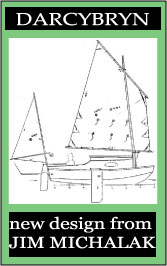We love our old magazines so here is a little treasure from the dusty old pages.
Yacht Tender by C. A. Macy
THE above plans show an excellent type of yacht tender, and any yachtsman who intends building a tender during the winter months for next season's use can not do better than to build on the lines given here through the kindness of Mr. C. A. Macy. Proof of the boat's good behavior is given by Mr. Macy, who writes as follows regarding her:
She is the best little boat to tow in fair weather or foul I have ever seen. You will notice I have drawn a ring or eye in the stem just above the water line, it is a phosphor bronze casting, and has a bolt through the stem riveted over a plate inside. Towing from that point I believe it almost impossible to capsize her by pulling the painter. I have seen her ride broadside on the crest of a breaking sea with slack painter, and the yacht running ahead take up the slack with a jerk and turn the tender completely around end for end, as it slid down the sea and not ship a drop of water. She will carry five ordinary men comfortably.
Her dimensions are: Length on top, 10 feet; water line, 8 feet 7 inches; beam extreme, 3 feet 8 inches; at water line, 2 feet 9 inches.
The Rudder, v.13 1902, p. 514.
12' Power Tender by Richard B. Cook
The accompanying plans show a 12-foot power tender designed bv Richard B. Cook and owned by Mr. Nathaniel W. Littlefield of Central Falls, R. L, who is using the boat as tender to a 38-foot yawl, which has no auxiliary power.
She is a good carrying boat, seating five comfortably, and has carried eight persons. After a season of cruising with prevailing light winds, the owner gives a good account of her as a towboat.
The boat is not designed for speed, as may be seen at a glance; her speed with two persons on board being about 4 1/2 to 5 knots. However, the plan shows smooth lines with a lean entrance and ample flare forward. The after forms have been made full, affording sufficient buoyancy to allow of the engine and all connected with it, including the operator, to be placed abaft the lazyback which divides the interior, leaving a seating space 4 by 5 1/2 feet clean and clear for passengers. This arrangement has the additional ad vantage of bringing all the weight aft when the tender is light and in tow.
The Rudder, v.27 1912, pp. 356-359.
13' Power Tender by Frederic Nock
The plans on the accompanying page show the lines and general arrangement of a thirteen-foot power tender designed and built by Frederic S. Nock, of East Greenwich, R. I., for Dr. F. T. Rogers, for use on his yawl Truant. The owner desired a light power tender, of not over 300lb weight, to carry on davits and capable of carrying six persons besides the crew. In the majority of the small power tenders, the engine is placed aft, and there fore the best of the boat is rendered useless as far as seating accommodations are concerned. Where the engine is not of any great weight the arrangement as shown is good, as it keeps the after part of the boat for the guests and forward for the crew. This boat was not designed to be towed astern of her consort and the weight of the complete boat is a trifle under 225 Ib. The planking is 3/8 in. cedar, the gratings, seats, sheerstrake, mouldings, etc., of mahogany.
The Rudder, v.18 1907, pp. 698-699.
Two More Yacht Tenders
Above, we show the plans of the two Universal-powered tenders for the yacht Nenemoosha. Both of these boats are of rather novel construction and the designer, E. R. Carroll, has not been bound by convention in getting them out. The tunnel stern boat will be used for fishing service and is arranged so that the owner can control the boat entirely from his fishing chair. She is 15 feet long, 4 feet 2 inches wide and only draws 6 inches with 3 men on board. The other boat will also be powered with a Universal engine and is strongly reminiscent of the English tenders. A feature is the crew cockpit and tiller steer arrangement. She is 16 feet long, 4 feet 6 inches wide and draws 16 inches.
The Rudder, v.38 1922, pp. 44-45.
|














